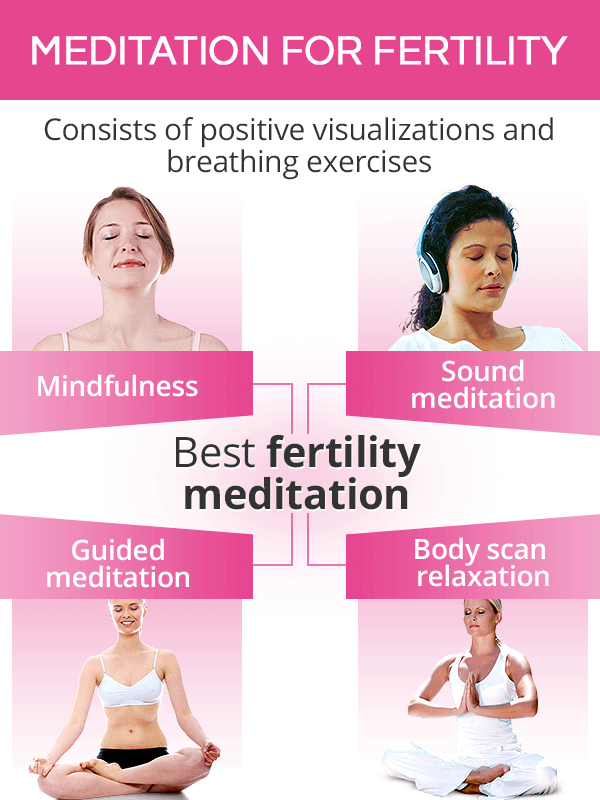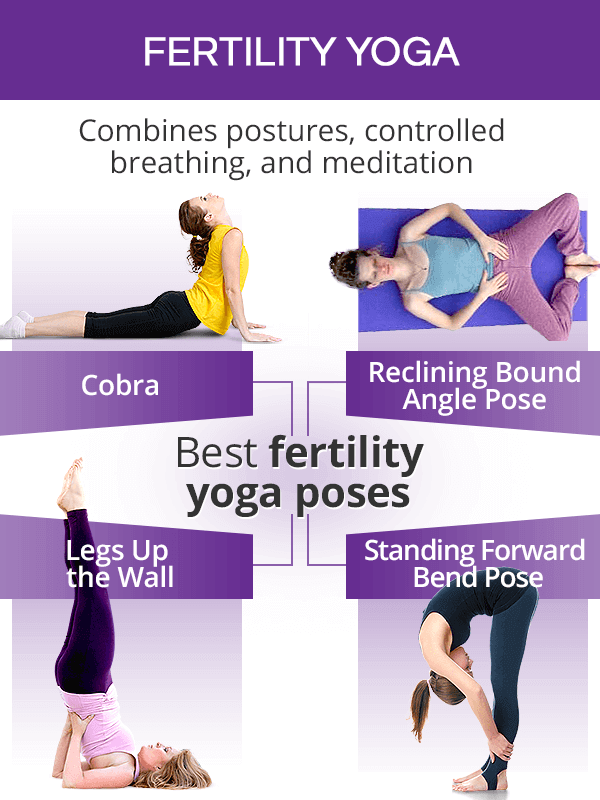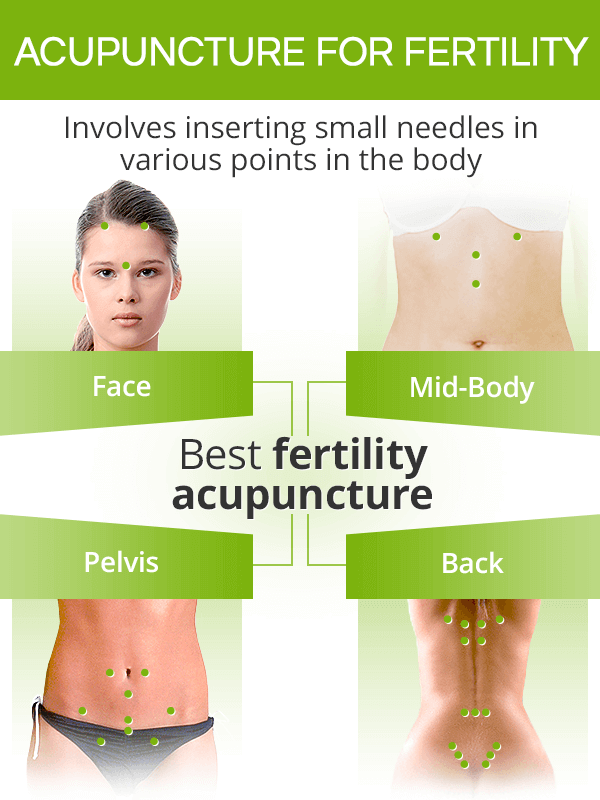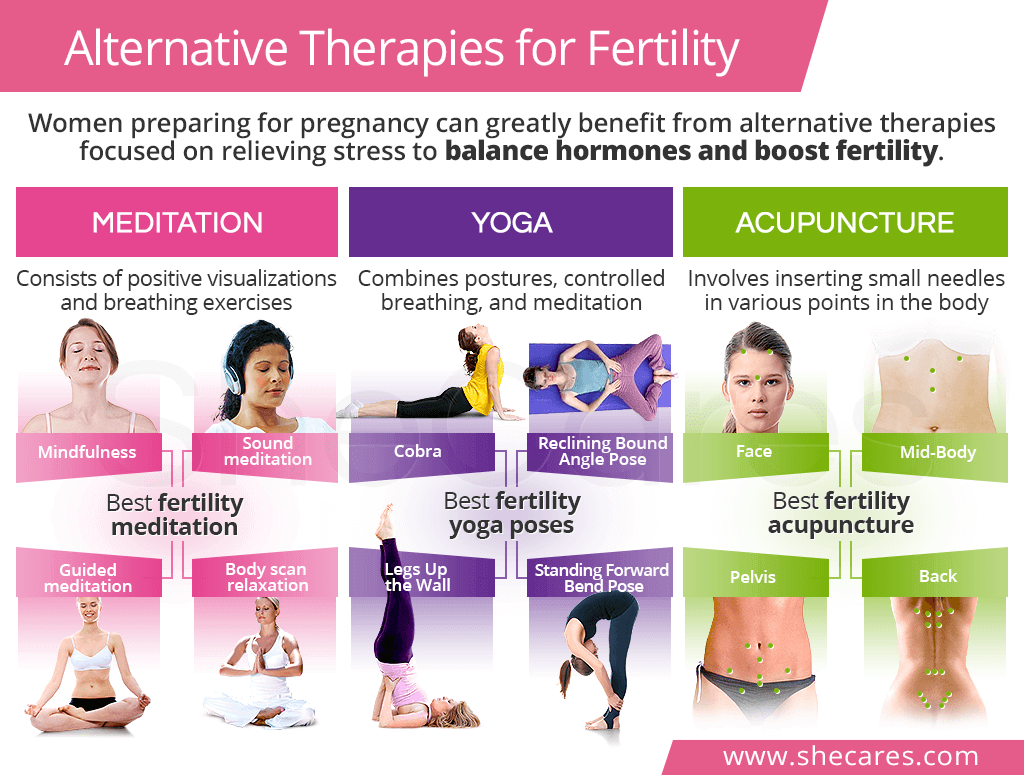Fertility-Boosting Meditation

What Is Fertility Meditation?
Meditation consists of various practices that raise one's awareness on the present moment, train the mind to control the incoming thoughts, and put the body in a relaxed state.
Why is Meditation Good for Fertility?
A number of studies designed to investigate the effects of meditation on fertility have found the following benefits:
Reduces stress and tension by lowering the levels of cortisol, the stress hormone
Helps balance hormones by relieving the negative effects of stress on the endocrine glands
Promotes mind clarity and a positive outlook, both of which are beneficial for better decision-making
Helps women feel more in control over their bodies, especially those suffering from infertility
How to Practice Meditation for Fertility?
There are numerous meditation techniques that can benefit aspiring mothers. For beginners, the goal is to focus on one technique by starting with 5-minute daily meditations and gradually building up to the length that fits one's lifestyle and preference. Some fertility meditation techniques to choose from might include:
Body scan relaxation consists of visualizing one's body to locate the areas where stress accumulates.
Guided meditation involves the use of imagery or sound to encourage positive visualizations about successful conception.
Mindfulness meditation brings one's attention to the present moment and the surroundings.
Sound meditation uses Sanskrit mantras, ancient sounds, to bring peace into the mind and body.
Fertility Yoga

What Is Fertility Yoga?
Yoga is an ancient system of postures, controlled breathing, and meditation recognized for its positive the effects on human body. Fertility yoga is popular among mothers-to-be as it allows them to reap double benefits, both physical and psychological:
Why is Yoga Good for Fertility?
Fertility yoga has been found to potentially aid a woman's conception efforts in the following ways:
Promotes hormonal balance by lowering accumulated stress and reducing anxiety
Increases blood flow to the reproductive organs to stimulate ovulation for improved fertility
Aligns the uterus and open the hips and pelvis to encourage easier conception
Improves libido and sexual satisfaction by toning pelvic floor muscles
How to Practice Yoga for Fertility?
Basic yoga courses are widely available on the internet (often for free) or through local yoga centers, and the best benefits are reaped with regular practice. Fertility yoga has two components: the physical postures (asana) and regulated breath (pranayama). Best fertility yoga poses include the following:
Legs Up the Wall Pose (Viparita Karani) is believed to help the sperm reach the released eggs faster to increase the chances of conception when done right after intercourse.
Reclining Bound Angle Pose (Supta Baddha Konasana) can relieve menstrual cramps and IVF-triggered discomforts.
Cobra Pose (Bhujangasana) helps boost uterine and ovarian blood flow and improve cervical mucus to ease sperm transport to the egg.
Standing Forward Bend Pose (Uttanasana) is said to stimulate the ovaries and the uterus, relieve stress from the pelvic region, and reduce the symptoms of premenstrual syndrome (PMS).
Caution should be exercised when choosing yoga poses as some might have adverse effects on fertility. Yoga practices that should be avoided include Bikram, Ashtanga, and Power Yoga.
Acupuncture for Fertility

What Is Fertility Acupuncture?
Acupuncture is a practice used in traditional Chinese medicine, which consists of gently inserting thin needles at various points in the body, referred to as acupoints, which correlate to larger body systems and their functions.
Why is Acupuncture Good for Fertility?
The association between acupuncture and infertility has been extensively studied in recent years to uncover the following benefits:
Regulates menstrual cycles and restores ovulation to make conception more feasible, especially in woman with polycystic ovary syndrome (PCOS) or endometriosis
Alleviates the debilitating effects of high cortisol levels on ovulation and fertility
Promotes hormonal balance by encouraging the endocrine glands to improve their function
Stimulates blood flow to thicken the endometrial lining and enhance successful egg implantation
Although acupuncture has shown to increase pregnancy rates for couples undergoing in vitro fertilization (IVF), a recent study has found that acupuncture performed on the day of embryo transfer to the uterus should be avoided as it significantly lowers the chance of successful implantation. Further studies are needed to validate these findings.
How to Practice Acupuncture for Fertility?
Acupuncture should only be done by a trained and licensed acupuncturist. Such specialist has knowledge of acupoints throughout the body in order to evoke the desired response. Some of the most popular points used in acupuncture for fertility are located in the following body regions:
Face includes points, like Epang II and Yintang, which are helpful in regulating menstrual cycles.
Mid-body acupoints, such as LV 14, Ren 14, or Ki 15, are used to improve libido and cervical fluid.
Pelvis contains several points, like Ki 16 or Ren 4, to increase uterine blood flow and boost conception.
Back-located acupoints, like UB 44 or UB 15, are beneficial for stress-relief and menstrual health.
Key Takeaways
When preparing for motherhood, taking care of the mind is equally important as improving one's physical health. Because research has identified prolonged stress as one of the main culprits behind infertility, efforts to release it naturally can drastically improve a woman's chances of getting pregnant quickly. Besides stress relief, alternative therapies, such as meditation, yoga, or acupuncture for fertility, can offer additional benefits, too. They include improving hormone production for more regular menstrual cycles, increasing blood flow to the reproductive organs for healthier ovulation, or improving libido for optimal conception. When a woman's mind and body are in harmony, she can open herself to the prospect of becoming a mother with more ease.
Sources
- Ancient Science of Life. (n.d.). Meditation and Yoga can Modulate Brain Mechanisms that affect Behavior and Anxiety - A Modern Scientific Perspective. Retrieved December 13, 2018 from https://www.ncbi.nlm.nih.gov/pmc/articles/PMC4769029/
- Fertility and Sterility. (2010). The use of complementary and alternative fertility treatment in couples seeking fertility care: data from a prospective cohort in the United States. Retrieved December 13, 2018 from https://www.ncbi.nlm.nih.gov/pubmed/20338559
- Greene, R. & Tarkan, L. (2008). Perfect Hormone Balance for Fertility: The Ultimate Guide to Getting Pregnant. Retrieved December 13, 2018 from https://www.amazon.com/Perfect-Hormone-Balance-Fertility-Ultimate/dp/0307337405
- Human Reproduction Update. (2013). The effects of acupuncture on rates of clinical pregnancy among women undergoing in vitro fertilization: a systematic review and meta-analysis. Retrieved December 13, 2018 from https://www.ncbi.nlm.nih.gov/pubmed/23814102
- JBRA Assisted Reproduction. (2018). Does acupuncture the day of embryo transfer affect the clinical pregnancy rate? Systematic review and meta-analysis. Retrieved December 13, 2018 from https://www.ncbi.nlm.nih.gov/pmc/articles/PMC6210608/
- Pacific College of Oriental Medicine. (2017). How dos Acupuncture for Fertility Work? Increase chance of conception without side effects. Retrieved December 13, 2018 from https://www.pacificcollege.edu/news/blog/2015/04/17/how-does-acupuncture-fertility-work-increase-chance-conception-without-side
- Your Fertility. (n.d.). Complementary and alternative therapies. Retrieved December 13, 2018 from https://www.yourfertility.org.au/everyone/health-medical/complementary-and-alternative-therapies


